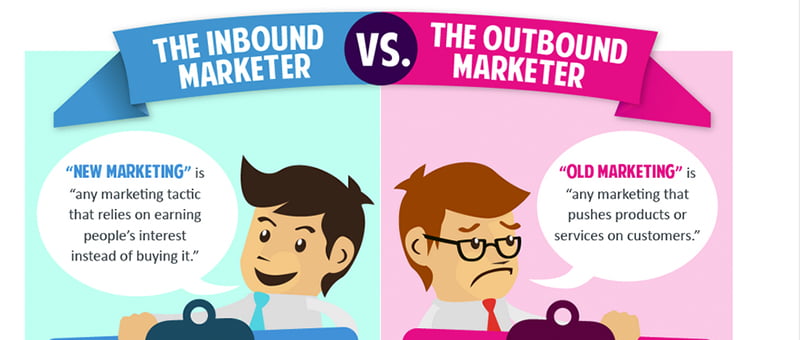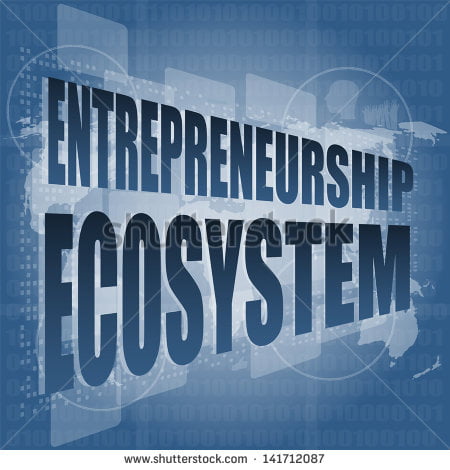Inbound vs. Outbound: Part 2
Why is inbound marketing better than outbound marketing?

Outbound Marketing: With outbound marketing, you are always the footnote. You are forced to stick out or not be seen at all. It makes your relationship with your customer based on attention-grabbing rather than value. If you are at the trade show you can have the best booth with the best giveaway prize, but you are not the keynote speaker. When you are advertising at the Super Bowl you can be the best commercial but the best commercial is merely a footnote to the main event. At best, with outbound marketing you might strive to be the best footnote. Unfortunately, to stick out in traditional advertising you usually have to sacrifice your message for a gimmick and hope that some of the people who see the gimmick look closely enough for the footnote.
Inbound Marketing: With inbound marketing, you are the story. You are the keynote speaker. Inbound marketing is all about creating great content to share with your audience. It’s about telling stories and speaking to your audience where they want to be spoken to, how they want to be spoken to. It’s about delighting them, educating them and engaging them in an open and transparent way. But inbound marketing is much more than simply being the keynote speaker at the trade show; it’s about being the article featured on the cover of the magazine. It’s about being the most valuable player at the Super Bowl. And when done correctly, inbound marketing can open up these amazing distribution channels that make it so you don’t have to wait for the next trade show, the next magazine or next year’s Super Bowl to show off your brand. You can do it on-demand with laser-like precision penetrating a group of your peers and the influencers in your industry.
Linear vs. Holistic

Outbound Marketing: With outbound marketing, the strategy is very linear. You only have so many marketing mediums to choose from like radio, TV, direct mail, tradeshow, billboard, sponsorships, etc. With this linear strategy, you assess which mediums most accurately address your target market and you start checking the boxes. You begin to attribute higher percentages of your budget to the more effective mediums and leave out the least effective mediums. You create a unified message across all mediums, and your job is done for the period. Come back again next period, sift through the data, reassess the percentages and do it again. Digital marketers can make the mistake of approaching the web with this outbound marketing approach. Social media, check! SEO, check! Email marketing- check!
Inbound Marketing: With inbound marketing, the strategy is holistic. Inbound marketing is a much more complex approach than outbound marketing. It takes simultaneous usage of all the digital channels, continuous strengthening of the website, development of effective content and implementation of measurement tools all in concert with one another to achieve these unparalleled results. Many digital marketers don’t understand the complexities, they stick with the approach that they are comfortable with, the outbound or linear approach applied to the digital world. This approach gets you the traditional results. The difference between digital marketing and inbound marketing are the complexities and the holistic approach.
Inbound marketing is like a holistic lifestyle — in order to carry out an inbound marketing campaign, a website needs to have a strong foundation. It needs to be in good enough shape to carry out strong messaging, a content marketing strategy and be a hub for distribution. It needs to have a blog, it needs to be responsive, it needs to have a call-to-action strategy, it needs to have micro and macro conversions and it needs to have an easy-to-use CMS. Once the website is in shape, the content can be created and the distribution can begin.
Content creation needs to be engaging and meet the objectives of your keyword strategy. The distribution needs to tap into all avenues: RSS-fed email for blog subscribers, social media channels, lead nurture campaigns, etc. But it is not the linear check-box approach of outbound. Inbound requires daily attention with constant analytical review. Like a holistic healthy lifestyle, it requires discipline and fortitude. Sometimes you need more content, sometimes you need more distribution, sometimes more landing pages, sometimes more blog posts, sometimes better conversion rate optimization, sometimes a stronger call-to-action strategy, but it always takes adjustment and strategy.
When a holistic inbound marketing strategy is hitting on all cylinders, your website is rock solid, your distribution is amplified and your distribution channels are feeding the website a steady diet of visitors, where prospects are being converted with the utmost optimization.
Obfuscate vs. Educate
Outbound Marketing: With outbound marketing, the message is inherently obfuscated, duplicitous and full of shit. It has to be. With very little room to work with, whether it be in a newspaper ad or a few seconds on the radio, the goal of outbound marketing has always been to stand out. And in order to do this, to be a clutter buster, the relationship with the client is compromised. Think about it: how else can we get someone to see your mortgage product in a quarter-page ad at the bottom of an article about Obamacare? If you’re lucky enough to know where the ad will appear, you can try to force the message to fit the audience, but this rarely succeeds, and more often than not, you’re trying to message males and females ages zero to one hundred with the same message. It’s all one big hoax. Misdirection. It’s pulling that shiny quarter from behind your ear.
Inbound Marketing: With inbound marketing, the message is specific and useful. Rather than forced upon you, the message is instead offered up on a nice shiny silver platter — ready for you to consume whenever convenient. This message contains quality content that educates and engages. It’s meant to answer a consumer’s question, to fill in the blank. I remember not long ago when marketing professionals would advise their clients to create deep discounts and BIG sales and then advertise them to the masses. The thought process was that more consumers would then thereby seek out the product and the increase in customers made up for the lost product value. The idea that I got paid to offer up that piece of bullshit advice is astonishing. The reality today is that instead of advising our clients to slash prices or advertise on all mediums, we instead encourage them to offer something of even greater value — thought leadership (and if we have to offer discounts, we offer them to our loyal brand ambassadors… a reward for subscribing).
Renting vs. Owning
Outbound Marketing: With outbound marketing, you are always renting your distribution. As most advertisers know, you’re only as good as your last campaign or your last media buy. If it works and sales get a bump, it’s on to the next campaign. If it fails, then jobs and budget are on the line. With an outbound campaign like direct mail, the leads come in for a couple weeks when the mail’s hitting households. Once those leads are processed and the mail is distributed, you need to start again, new message, new distribution.
All marketers know there is only one good tradeshow a year, the rest are all washes. The Super Bowl only comes once a year, the World Cup eventually comes to an end, and the newspaper gets recycled tomorrow. Nothing in outbound marketing is iterative, and there are always costs associated with lead generation. This often makes for a negative ROI, finicky CEOs and an overall high-pressure job.
Inbound Marketing: With inbound marketing, you own your distribution and it depreciates much more like an asset. You build up your subscription-based email list, you earn a top ranking on product-related keywords, you build a following on social media and voilà: you are creating assets. There is a cost of acquisition (creating the content), but it is iterative and it keeps working for you long after you stop the acquisition/creation phase.
For the first time in a marketer’s career, we are creating value that will last beyond our tenure. Create a 20,000-person email list, acquire 50,000 social media fans, rank in the top 10 for 400 plus keywords with a total search volume of 1 million monthly searches and you’ve created a Super Bowl opportunity every month of the year. There are companies (Hubspot) literally lobbying our federal government to allow them to book inbound marketing as an asset instead of an expense. It makes a lot of sense. If you have 10,000 blog posts generating 1,500 leads per month through online searches and you stop posting for a year, that lead volume will likely only diminish slightly. Over the years, you might see some fall-off, but it is a lot more like depreciation of traditional assets. Needless to say, this is the type of marketing that makes CEOs happy and makes heroes out of the marketing department.
Immeasurable vs. Quantifiable

Outbound Marketing: With outbound marketing, the success of the marketing is hard to measure. We can ask our prospects how they heard of us, but in general, the results are unreliable. This makes for a margin for error that is inherent within this archaic and linear model of marketing. Sure, it’s great to hear that the company call center received a few dozen calls as a result of a targeted marketing effort. It’s also great when someone fills out the “How Did You Hear About Us?” form, but this doesn’t tell the whole story. The margin of error occurs when you assume you know the whole story and assumptions lead to underperforming campaigns. The measurement of outbound marketing lacks complexity and a lack of complexity leads to a lack of results.
Inbound Marketing: With inbound marketing, everything is digital, and everything is quantifiable. There’s no need to assume anything. Complex algorithms track not only if your marketing strategy is effective, but also if it is converting potential customers into full-blown clients. An inbound marketing strategy is highly measurable. It allows for analysis of everything from the ROI of various distribution methods to whether the size and shape of a CTA button is more likely to attract a customer or not.
What I love most about inbound marketing is that it allows for closed-loop reporting. It lets me track someone’s IP address from the second it hits our website; it tells me how that IP address got there and how much time it’s spending on the site. It gives me an in-depth glimpse into the thought process of a consumer — showing me which blog posts they have read, which pages they viewed, whether they entered the site organically or through another avenue like social media, and lead generation metrics. Again, inbound marketing is highly measurable.
Inbound marketing succeeds because it allows you to talk to people who have given you permission, and to tell your story in a holistic, educational way on your own distribution platform, with quantifiable metrics. We know this to be true because we’ve experienced the shift, from our founding days in branding in 2001, through the rise of the digital marketing age and into this new era of inbound marketing. Why is inbound marketing better than outbound marketing? It works. We’ve made it work for us and our clients. Talk to us to see how we can make it work for you.
Chuck Reynolds
Contributor
–
Alan Zibluk Markethive Founding Member
























